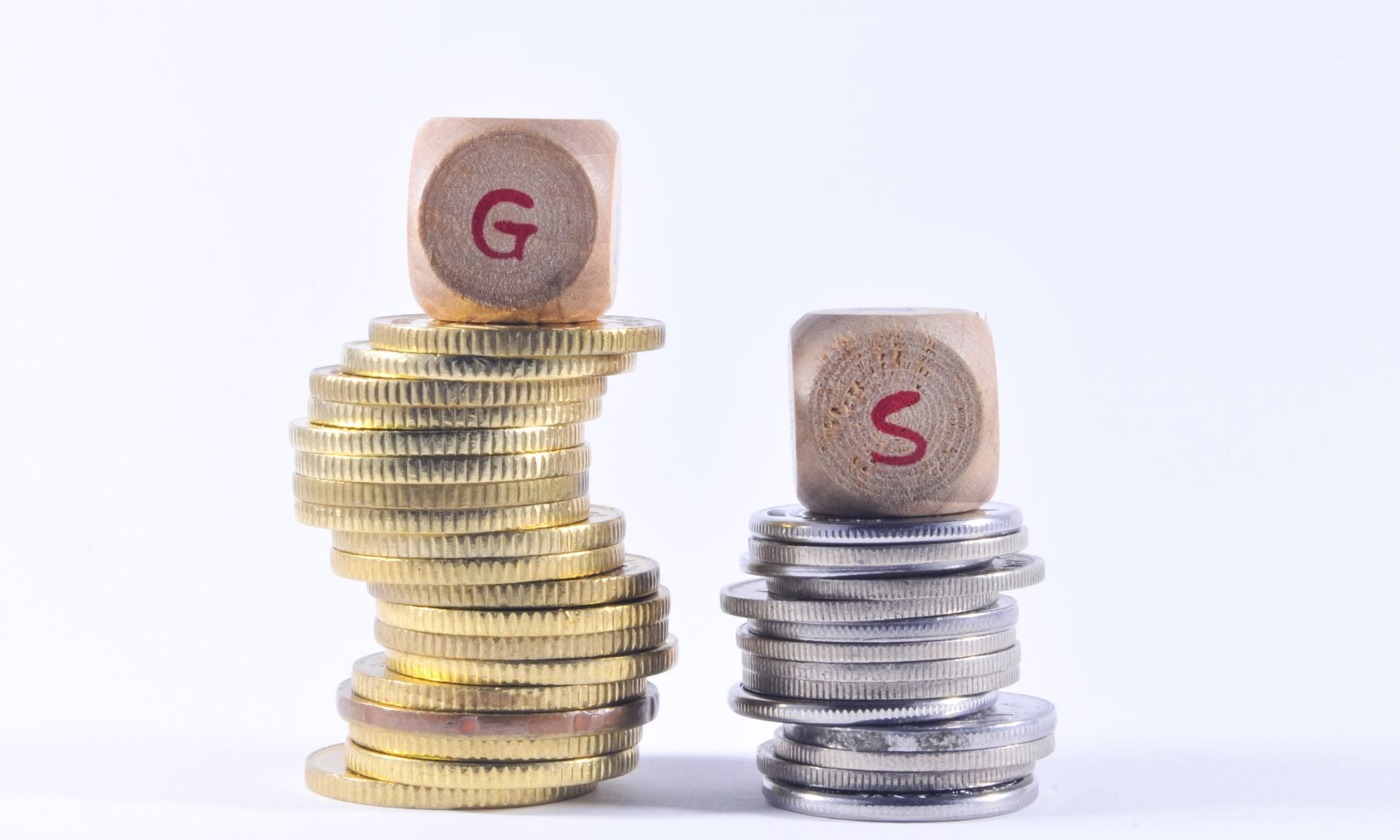Gold and silver have long been popular alternative investments, prized for their tangible value and role as inflation hedges. But when it comes to choosing between the two precious metals, which makes the better investment option? There are good arguments on both sides.
How Gold and Silver Perform as Investments

Over the past century, gold has significantly outperformed silver in terms of average annual returns. According to historical data analyzed by Creighton University Professor Robert Johnson, gold prices increased at a 4.87% annual compound rate between 1925 and 2020. Meanwhile, silver lagged at 3.46%.
However, these returns look less impressive when accounting for inflation, which averaged 2.9% per year over the same stretch. Gold’s inflation-adjusted return shrinks to just 1.97% compounded annually, while silver managed a mere 0.56% annually above inflation.
Still, gold maintains a clear edge – and stands out when compared against other common investment assets. As Johnson highlights, a $20 investment in the S&P 500 index in 1925 would have grown to $225,788 by the end of 2020 thanks to a 10.3% annualized return over those 95 years.
So why do investors continue pouring money into precious metals when far higher returns have been available on stocks? The answer lies in gold and silver’s perceived safety and value preservation abilities.
Gold as an Inflation Hedge and Safe Haven
Gold’s status as an inflation hedge stems from its intrinsic value and limited supply. As a rare precious metal with myriad industrial and decorative uses, gold tends to hold its purchasing power over long stretches rather than depreciating. When inflation expectations rise, investors often flock to gold, driving up its nominal price and offsetting diminished real returns on fixed-rate assets like bonds.
This inflation-hedging ability also feeds into gold’s safe haven appeal. Its value isn’t tied to economic growth and business cycles in the same way as stocks and other risk assets. Gold prices often spike during financial crises as anxious investors sell volatile assets and move capital into safer stores of value.
However, the connection between gold and inflation isn’t perfect, especially over short time horizons. Rapidly rising interest rates triggered by inflationary pressures can make income investments like bonds more attractive, diverting capital away from gold markets. Still, over long periods encompassing multiple business cycles, gold has lived up to its billing as an inflation-resistant asset.
Silver’s Dual Role as Industrial and Precious Metal
Unlike gold, silver features more practical real-world applications beyond just storing value. As an industrial metal, silver plays a critical roles in products like batteries, solar panels, electronics, medical devices, glass coatings, and water purification systems. This means silver demand – and pricing – depends significantly on global economic growth and manufacturing activity.
During recessions, lower industrial silver consumption is often offset by higher investment demand, as investors buy it as an inflation hedge similar to gold. The opposite occurs during periods of strong expansion and low inflation: industrial use rises while speculative investment wanes. This balance between industrial and financial demand introduces silver price volatility that gold doesn’t face to the same degree.
In recent decades, technological innovations have spurred rapid growth in industrial silver applications, especially electronics and photovoltaics. With global initiatives to combat climate change incentivizing greater adoption of clean energy like solar power going forward, long-term demand for silver as an industrial metal appears robust.
Comparing Gold and Silver Volatility
Due to its dual market influences and lower market value, silver demonstrates higher short-term price volatility than gold. Silver’s lower liquidity exacerbates this, as supply and demand imbalances can spark more dramatic price swings.
However, some analysts argue silver’s increased volatility can benefit traders while making only a modest dent in long-term returns for buy-and-hold investors. More significant silver price corrections provide profit-taking or buy-low opportunities for active investors. And secular growth trends in key silver-consuming industries could facilitate multi-year bull runs.
Meanwhile, silver bullion and silver mining stocks offer increased sensitivity to spot price gains. A silver investment doubles in nominal value following a 100% spot price increase; a comparable gold investment would require a price surge from $1,800 to $3,600 per ounce. This asymmetric upside exposes silver investors to risky but potentially lucrative opportunities.
Factoring Scarcity Into Gold vs Silver Outlooks
Scarcity also differentiates gold and silver investment outlooks. All the gold ever mined could fit into a cube approximately 20 meters on a side, demonstrating immense value concentrated in a relatively small amount of physical matter. And gold ore grades have declined substantially over the decades, making new supply more challenging to access cost-effectively.
Unlike gold, above-ground silver stockpiles are difficult to accurately quantify due to the metal’s multitude of applications. But estimates suggest total silver supply stands around 1 billion ounces. Annual mining output falls between 750 million and 850 million ounces, supplemented by recycling of silver byproducts from other metal refining processes.
Recycled silver contributes over a quarter of total supply each year. So unlike gold, much of the accumulated above-ground silver remains theoretically recoverable even if currently residing in landfills. Continued industrial demand growth could make enhanced recycling initiatives economically feasible, limiting risks of severe supply shortfalls. However, like gold, costs associated with locating new high-grade silver deposits continue rising.
Weighing the Investment Merits of Gold vs Silver
So weighing all the variables, which precious metal stacks up as the smarter buy? Unfortunately there’s no consensus amongst financial analysts and investors.
- For those prioritizing long-term inflation protection and wealth preservation, gold boasts a better track record and reputation as crisis hedge.
- Investors focused on maximizing risk-adjusted returns may favor a diversified portfolio not overexposed to precious metals.
- Traders attracted to silver’s increased volatility can try capitalizing on more frequent price swings.
- Believers in a secular bull case for precious metals could argue we’re still early in the current cycle, with both gold and silver poised for further gains.
In reality, incorporating some exposure to both gold and silver allows investors to tap into the best traits of each metal. The optimal allocation comes down to personal risk tolerance, desired liquidity, portfolio size, and macroeconomic outlook.
Gold and Silver Investment Options
While building a safe or jewelry collection represents one way of gaining precious metals exposure, investors have plenty of options for participating in gold and silver price moves without directly owning bullion. Some popular methods include:
- Precious metals ETFs – Exchange-traded funds like GLD and SLV offer liquid equity-like vehicles for betting on gold and silver spot prices.
- Mining company stocks – Shares of gold and silver producers provide leveraged exposure to underlying commodity prices. Risks and costs associated with extraction introduce volatility.
- Gold/silver-backed cryptos – Digital tokens like PAX Gold and Tether Gold offer blockchain-based alternatives to owning physical bullion.
- Precious metals IRAs – Allow investors to hold physical gold and silver coins or bullion in a tax-advantaged Individual Retirement Account structure.
Conclusion: A Case for Holding Both Precious Metals
Rather than viewing gold and silver as pure competitors, investors should consider their complementary strengths when forming precious metals strategies.
Gold offers time-tested history preserving purchasing power over the long run, providing insurance against both inflationary spikes and financial market dislocations. Silver acts as more of a hybrid asset, benefiting from rising economic optimism and surging industrial demand even amid stable inflation, while also attracting haven-seeking capital during periodic gold rushes.
Given these differing return drivers, holding some combination of both metals diversifies risks associated with committing solely to either gold or silver. The optimal allocation depends on individual investor risk preferences, time horizons, portfolio constraints, and beliefs around which macro conditions seem likeliest in coming years. But holding at least small positions in both gold and silver ensures exposure to whichever precious metal ends up outperforming over the next decade and beyond.
FAQs About Investing in Gold and Silver
Is gold or silver a better long-term investment?
Historically gold has generated superior long-term returns with lower volatility, making it likely the better precious metal for conservative buy-and-hold investors focused on wealth preservation. However, silver offers more exposure to potentially lucrative industrial demand growth.
What drives price fluctuations in the gold and silver markets?
Gold prices primarily reflect inflation expectations and capital flows between asset classes during financial/economic crises. Silver prices fluctuate based on industrial supply/demand shifting with the business cycle, along with investment capital flows triggered by monetary policy and inflation expectations.
Which metal offers better inflation protection?
Gold’s track record as an inflation hedge is stronger than silver’s over multi-decade periods. However, silver’s dual precious/industrial metal dynamics could make it more resilient should rising inflation appear alongside economic stagnation.
Does silver or gold have better upside potential shortly?
If inflation remains persistently and unexpectedly high over the mid-term, gold seems poised to ascend into record territory given its reputation as crisis hedge. Meanwhile any acceleration in silver-intensive technology adoption like solar power and EVs would propel robust investment and industrial demand growth.
What causes gold and silver crashes?
Sharply rising real interest rates make income investments like bonds relatively more attractive, prompting heavy rotations out of perceived safe-haven assets like gold and silver. Positive real rates also incentivize banks to restrict lending, tightening credit conditions and ultimately weighing on speculative precious metals positioning.
In another related article, Noble Gold Investments Review 2023: An In-Depth Analysis of America & Top Gold & Silver IRA Company





